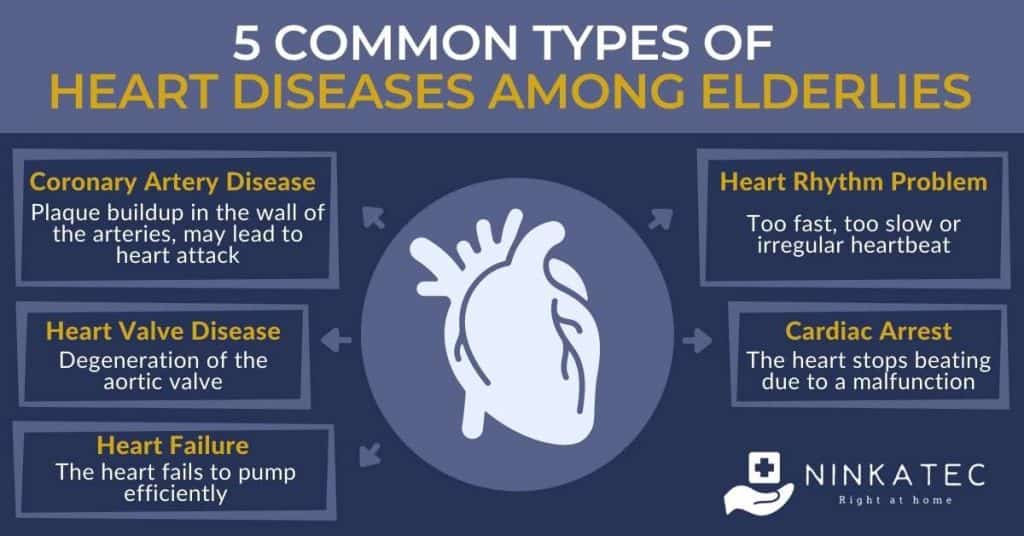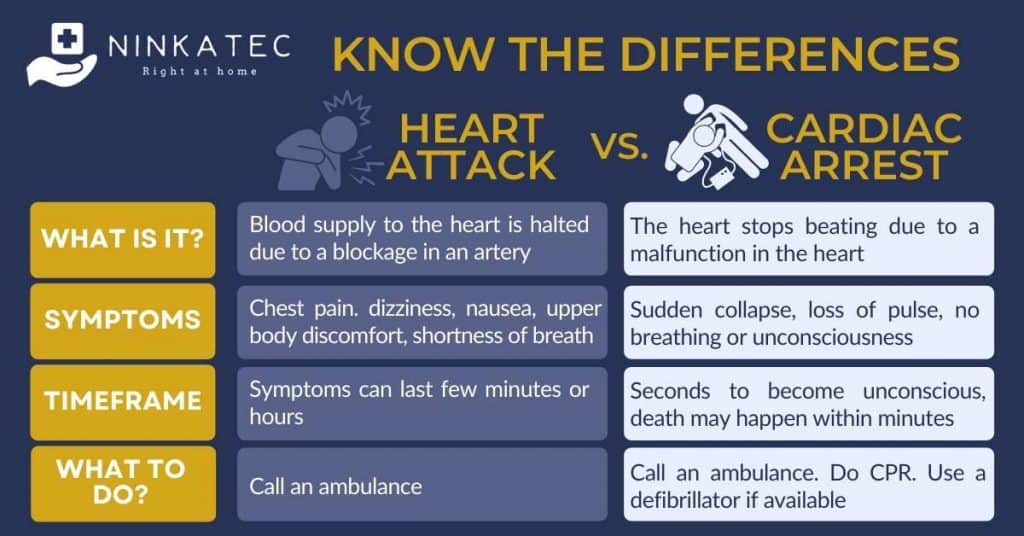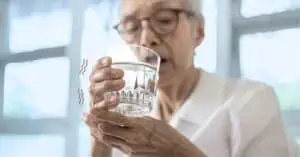Table of Contents
Heart and cardiovascular diseases rank among the top causes of death in Singapore
According to statistics, almost 1 in 3 deaths in Singapore is caused by cardiovascular diseases. Ischemic heart disease, which can be loosely understood as heart attack, account for almost two thirds of the cases. Across the island emergency departments receive estimatedly 33 heart attacks and 21 strokes every day - a testament to the relentless threat of these conditions.
As our population ages, the battle against heart and cardiovascular disease becomes even more critical. The rise in chronic conditions that are common risk factors for cardiovascular disease such as diabetes, high blood pressure, high cholesterol and high triglyceridesis is alarming. This trend underscores the urgent need for awareness and preventative measures early on, particularly among the elderly.
Stay informed and empowered to safeguard yourself and loved ones against heart and cardiovascular disease.
Heart disease, coronary heart disease vs. cardiovascular disease
Heart disease and cardiovascular disease are sometimes used interchangeably by the general public. However, medically speaking, they are related but not the same. Cardiovascular diseases is an umbrella term that encompasses a whole range of conditions that affect the heart and blood vessels, while heart conditions only refers to diseases of the heart. Thus, all heart diseases are cardiovascular diseases, but the opposite is not true.
Sometimes, you may hear people refer to a particular type of heart disease - coronary heart disease - as "heart disease". This is because coronary heart disease is the most common type of heart condition. The term "coronary" refers to the arteries supplying blood to the heart muscle. These arteries are crucial because they provide the heart with the oxygen and nutrients it needs to function properly. Coronary heart disease is also known as coronary artery disease (CAD).
In this article, we will focus on heart diseases (a separate article on our blog discusses cardiovascular diseases). Read on to learn to identify their signs and symptoms and understand risk factors, with a particular focus on the critical role cholesterol plays in your cardiovascular health. We know the medical terminology can be complex, but don't worry! We’ll break down the jargon and clarify common terms to ensure you have the knowledge you need to take charge of your heart health.
Aging and the increased risk of heart disease
The human heart beats over 100,000 times a day. That is 35 million times in a year, and more than 2.5 billion times in an average lifetime. With all that hard work, it's no surprise that our hearts can experience "wear and tear" as we age, causing degeneration in parts of the heart and heart diseases.
Exposure to other risk factors can also accumulate over a lifetime, putting seniors at higher risk of cardiovascular diseases. For example, one of the most common age-related changes to the body is the hardening of the arteries. When the arteries are hardened, they can't expand easily, making it harder for the heart to pump blood through. This increases the pressure on the heart and can eventually lead to heart problems.
Common heart diseases among elderlies in Singapore
The heart can malfunction when any of its parts fail to function properly. Below are the most common heart-related issues:
- Coronary Artery Disease (CAD): This occurs when the arteries that supply blood to the heart narrows and hardens, primarily due to the buildup of plaque inside the blood vessel. One of the most serious complications of coronary artery disease is heart attack.
- Aortic Valve Disease: When the aortic valve degenerates, it can lead to symptoms like shortness of breath, dizziness, and fainting. This condition may progressively worsen and potentially requires surgical intervention for treatment.
- Heart Rhythm Problems (Arrhythmias): The heart beats too fast, too slow, or irregularly. This disrupts normal heart function and can lead to more serious conditions, necessitating medical evaluation and possibly ongoing treatment.
- Heart Failure: In heart failure, the heart cannot pump blood efficiently, which leads to symptoms such as fatigue, fluid buildup, and shortness of breath. This condition typically worsens over time and requires comprehensive management including medication, lifestyle changes, and possibly device implantation.
- Cardiac Arrest: Cardiac arrest is a sudden loss of heart function, usually due to a disruption to the heart’s pumping action. As a result, blood flow to the rest of the body stops. This is an emergency situation, CPR and defibrillation and immediate medical intervention is critical to survival.
Each of these conditions poses significant health risks and requires attention from healthcare professionals for diagnosis and management, emphasising the importance of regular cardiac checkups for at-risk individuals.
In the following part of the article, we will discuss
- Coronary heart disease
- Heart attack
- Cardiac arrest
- Congestive heart failure
- Cardiac arrhythmias
- Valvular heart disease
1. Coronary Artery Disease
Coronary heart disease happens when the blood vessels that supply blood and oxygen to your heart muscle become narrow and hard. This is usually due to a process called atherosclerosis, where a sticky substance called plaque builds up inside the arteries. This buildup can happen over many years and is often due to a combination of factors such as diet, lifestyle, health conditions, age and genetics.
Symptoms of coronary artery disease may include chest pain, shortness of breath, light-headedness, and nausea. However, not everyone with the condition experiences symptoms. Some people find out they have coronary artery disease only when a serious complication happens.
Having coronary heart disease increases your risk of having a heart attack, but it does not mean it is inevitable. A heart attack occurs when one of the arteries becomes completely blocked suddenly, usually by a blood clot forming at the site of a plaque. While coronary heart disease raises the risk, many people live long, active lives with this condition by managing it effectively.
Treatment of coronary heart disease involve medications, lifestyle changes and procedures if necessary:
- Medications such as statins to lower cholesterol, blood pressure medications, or aspirin to reduce the risk of clots.
- Lifestyle changes: Adopting a heart-healthy diet, getting regular exercise, quitting smoking, and reducing alcohol intake.
- Procedures if necessary: In more severe cases, procedures like angioplasty (where the arteries are widened) or surgery such as bypass surgery might be needed.
2. Heart Attack
A heart attack, medically known as myocardial infarction (MI), often happens suddenly, causing irreversible impact to the heart and even death.
How does a heart attack happen?
The heart needs oxygenated blood to function. The coronary arteries are responsible for delivering oxygenated blood to the heart muscle. In some individuals, the artery is blocked, due to a fatty structure known as the atheroma or atheromatous plaque which has over time formed inside the vessels of the coronary arteries. When a coronary artery gets completely obstructed, blood can not reach some parts of the heart. As a result, the area in the heart without any blood supply will starve and die. This is called a heart attack.
Early signs of a heart attack
When the heart doesn’t receive sufficient blood supply, the heart muscle is usually strong enough to withhold the lack of oxygen and nutrients for some time. However, there could be early signs. By recognising these signs and symptoms of a heart attack, you can act quickly to receive timely medical attention. Here are the early signs and symptoms of a heart attack:
- Chest pain or discomfort
- Stomach pain
- Pain in your arm
- Sweating
- Difficulty breathing
- Getting tired quickly
Treatment of a heart attack
A heart without blood supply may be damaged quickly; thus people having a heart attack or suspected to have a heart attack need immediate medical treatment. The treatment of heart attack primarily focuses on alleviating the obstruction in the blood vessel. Depending on the severity of the cases, we can achieve this by drug to break down the clot obstructing the blood vessel, or procedure called Percutaneous Coronary Intervention (PCI) or Coronary Angioplasty (also called heart cath, cardiac cath, or cardio angiogram) to destroy the clot and restore normal blood flow to the heart muscle.
3. Congestive heart failure (CHF)
Congestive heart failure often referred to as heart failure, is a chronic condition involving the malfunction of ventricles of the heart - the compartments responsible for pumping blood out of the heart. CHF is often the result of decades of unhealthy lifestyle choices that gradually wreaks havoc on the heart’s chambers.
How does a congestive heart failure happen?
The heart has 2 ventricles. The left ventricle is responsible for pumping oxygenated blood to the body while the right one is responsible for pumping deoxygenated blood to the lung. The most commonly affected compartment in CHF is the left ventricle, leading to a dilated heart chamber that is unable to properly pump blood. As a result, blood and fluid quickly build up in parts of the body such as limbs, abdomen, lung or liver and medical intervention is required urgently.
Early signs of a congestive heart failure
Signs and symptoms of this chronic condition manifest differently through stages of the disease. Early warning signs of a heart failure may include shortness of breath, fatigue, loss of appetite, swelling, persistent coughing when fluid builds up in the lung, chest pain, and temporary loss of consciousness. Individuals suffering from chronic blood hypertension, valve diseases (e.g., stenosis, regurgitation), and genetic conditions (e.g., Marfan syndrome) are more likely to develop CHF.
Treatment of congestive heart failure
Depending on the stage of the disease, the severity of the symptoms and therapeutic approach will vary. At an early stage, depending on how CHF affects the individuals, doctors can prescribe lifestyle modifications and pharmacological drugs such as drugs to slow down the heart rhythm, or drugs to improve blood flow, or diuretics to reduce fluid retention in the body. However, as the disease progresses, patients may require cardiac transplantation to replace the defective heart.
4. Heart rhythm problem (Cardiac arrhythmias)
Arrhythmias are sometimes simplified and referred to among the general public as irregular heartbeat. This umbrella term covers a diverse range of more than a dozen categories of conditions, involving too fast or too slow heartbeat, presenting with palpitations, syncope, and other general symptoms.
How does a heart rhythm problem happen?
It is a common condition among elderly adults, resulting from an irregular electrical activity in the heart muscle and may cause a heart failure or stroke down the road. Atrial fibrillation is the most common type of heart rhythm problem among adults over 65 years old.
Signs and symptoms of heart rhythm problem
Heart rhythm problems sometimes do not show any signs and symptoms. Patients often find out they have heart rhythm problem from ECG test. Other times, they just feel their heartbeats are irregular, or their chest tightening, or a dizzy, light-headed sensation. In a few cases, heart rhythm problem is discovered when a complication such as stroke or heart failure happens.
Treatment for heart rhythm problem
Treatment for cardiac arrhythmias aims to manage heart rate and prevent complications. It often involves the prescriptions of antiarrhythmic medications, the implantation of pacemakers, and in some cases, surgical procedures.
5. Valvular heart diseases
This group of diseases involve the malfunctioning of the heart valves. There are 4 valves inside the heart that get affected in two ways:
- Restricted valves that do not open properly (valvular stenosis)
- ‘Floppy’ valves that do not close properly (valvular regurgitation)
How does a valvular heart disease happen?
As the body and the heart ages, the heart valves may be less efficient, causing valvular heart diseases. They can happen as a result of an infection or other heart diseases that damages the heart valves. Other cases are congenital.
When the valves are affected in either of the two ways above, the heart can’t pump blood properly, leading to an overworked heart. Blood may also leak during the process, leading to other heart conditions such as heart failure, cardiac arrest (more about this in the next part), and even death. The most commonly affected valves are the mitral and aortic valves - the 2 valves connected to the left ventricle which is responsible for receiving and pumping oxygenated blood.
Common signs and symptoms of valvular diseases:
- Heart murmur
- Cardiac arrhythmias
- Shortness of breath
- Swollen ankles
- Signs and symptoms of CHF in the case of severe forms
Treatment for valvular heart diseases
Treatment’s objective is to manage the symptoms with medicines. Surgery may be required if the affected valve is severely affected, to improve the functioning of the valve or replace it, depending on the causes of the disease and the condition of the valve.
6. Cardiac arrest
Cardiac arrest is an umbrella term used to describe an electrical dysfunction of the heart, which halts the function of pumping blood to the body, including to critical body parts such as the brain and the lung.
How does a cardiac arrest happen?
The heart relies on an ‘electrical system’ to beat regularly. Cardiac arrest happens when this ‘electrical system’ malfunctions - similar to an electricity blackout at your home. This causes the heart to stop pumping blood to the rest of the body. Patient quickly stops breathing, falls into unconsciousness, and without immediate medical attention, may die.
Cardiac arrest may happen as a result of heart rhythm problems, including ventricular fibrillation (VF). It often happens suddenly and quickly, and is not to be mistaken with a heart attack. Cardiac arrest can be thought of as an ‘electrical problem’ where the electrical system of the heart itself malfunctions, while heart attack is a ‘pumping problem’ where the pumping power of the coronary artery malfunctions, leading to lack of blood supply to the heart. They are however related. Patients suffering from heart attack are at higher risk of cardiac arrest.
Common signs and symptoms of cardiac arrest
- Gasping, abnormal breathing or no breathing
- Loss of pulse
- Unconsciousness
- Sudden collapse
Treatment for cardiac arrest
Cardiac arrest victims need to receive CPR (Cardiopulmonary Resuscitation) immediately while waiting for professional medical care.
At hospital, to rescue patients with cardiac arrest, doctors shock the heart with electrical pads in an attempt to reset the electrical current inside the muscle. The scene of rescuing a patient suffering from cardiac arrest is often depicted in movies and TV shows. Subsequent treatment involves pharmaceutical drugs and surgeries to treat the damage to the heart during cardiac arrest and the underlying causes if any.
7. The risk factors of heart diseases
The pathogenesis of a heart attack is complex. However, most researchers think of it as a combination of non-modifiable risk factors which we can not control, such as genetic predisposition, gender, and age; and modifiable risk factors such as smoking, uncontrolled diabetes, uncontrolled blood hypertension, high LDL (i.e., bad cholesterol) levels, obesity, and sedentary lifestyle (more on that later).
Non-modifiable risk factors
1. Advanced age
The vast majority of people who die from myocardial infarction are above the age of 65.
2. Family history
Having a family history of heart disease increases the risk of this condition for their children. Asians, in particular, seem to have a higher risk of developing heart disease relative to Caucasians. However, this is only true for American-Asians, who tend to live an unhealthy lifestyle in the United States.
3. Gender
Generally speaking, men have a higher risk of myocardial infarction compared to women. Additionally, men tend to experience heart attacks earlier in life. Note that there is a risk increase of cardiovascular disease after menopause, where the levels of protective hormones (e.g., estrogen, progesterone) drop.
4. Previous history of heart diseases
If you experienced any heart problems before, your risk of future episodes inadvertently increases.
Modifiable risk factors:
5. Smoking
Smokers have a significantly higher risk of heart disease relative to nonsmokers. It is an independent risk factor that also interferes with other elements. Note that second-hand smoking also elevates the risk of dying from a cardiovascular event.
6. Obesity
People who have excess body fat, especially in the abdomen and waist, are prone to heart disease and stroke. Conversely, losing weight can tremendously lower your risk of these conditions.
7. Sedentary lifestyle
Living a sedentary lifestyle predisposes people to myocardial infarction. Experts recommend getting regular physical activity for at least 150 minutes a week to lower your risk.
8. High cholesterol
High blood cholesterol, along with the other risk factors listed above, makes up the perfect recipe for cardiovascular disease.
Here are the items to keep in mind:
Total cholesterol
To calculate your total cholesterol score, follow this equation:
Total cholesterol = HDL + LDL + 20% of your triglyceride level
As a general rule of thumb, you need to keep your high-density-lipoprotein (HDL) cholesterol high since it protects your blood vessels and your low-density-lipoprotein (LDL) low.
A blood test can reveal your cholesterol level at the time of testing. If you carry many of the risk factors, it is vital to screen your cholesterol levels to take measures early on.
9. High blood pressure
High blood pressure, or hypertension, increases the workload of your heart, which negatively impacts the muscle fibers and blood vessels. Make sure to measure your blood pressure regularly in order to lower your risk of heart disease.
10. High blood sugar
High blood sugar seen in diabetes increases your risk of cardiovascular disease. Controlling your glucose levels should be your number one priority to reduce the risk of a myriad of diseases. If you have diabetes, be sure to work with your doctor to find the best ways to manage this condition.
8. Preventing heart and cardiovascular diseases for yourself and elderly loved ones
The early identification of cardiovascular risk factors is vital to lower the rates of fatal complications. We hope that this article helps you appreciate the risk factors of heart diseases and how you can prevent many of the modifiable risk factors. Awareness of cardiovascular conditions is the best way to lower the incidence and mortality of this condition for yourself and your senior family members.
For this reason, Singaporeans are recommended to get regular screenings of their modifiable risk factors. Eligible Singaporeans can participate in the Screen For Life program to benefit from subsidised or free of charge screening for heart diseases.
Managing cardiovascular conditions at home with Ninkatec
Ninkatec provides cardiology care solutions for those who are healing from heart conditions at home. Our cardiology care process starts with consultation with Ninkatec Care team and assessments by Ninkatec’s Cardiologist. After that, eligible patients will be recommended with suitable cardiology care plan, which includes remote monitoring of vital signals and 24/7 support from the Cardiology specialist team. Depending on the patient’s needs, the following services might also be recommended:
- Urosheath/urine output monitoring
- BP monitoring
- Continuous ECG monitoring
- Telehealth BP monitoring
- Cardiologist home visit
- Nursing visit
- Cardiology support at home
With Ninkatec’s curated cardiology care solutions, seniors having cardiovascular conditions can be assured of utmost care right in the comfort of your home.
Article is reviewed by Dr Woo Jia Wei, Sunrise Heart Specialist Clinic











